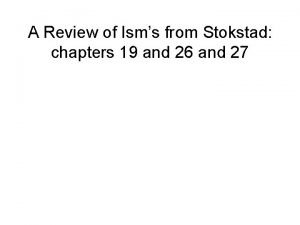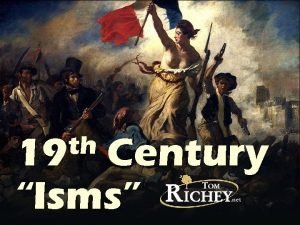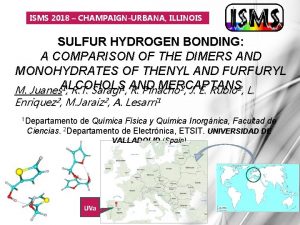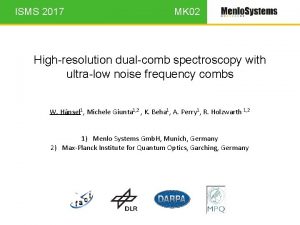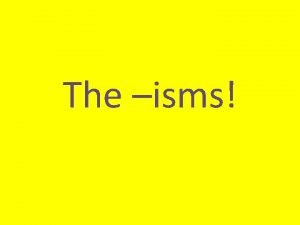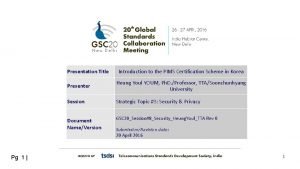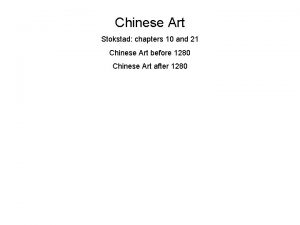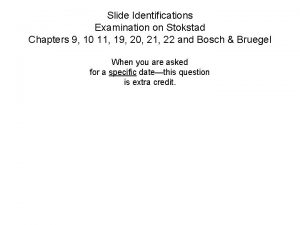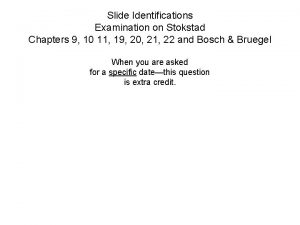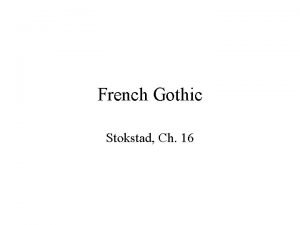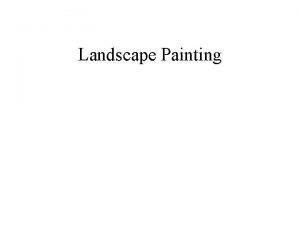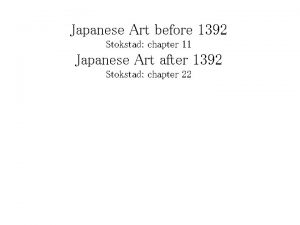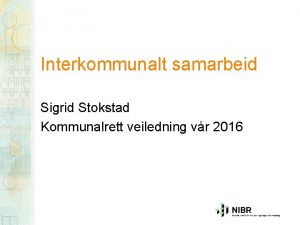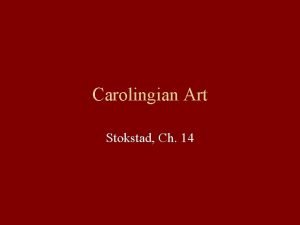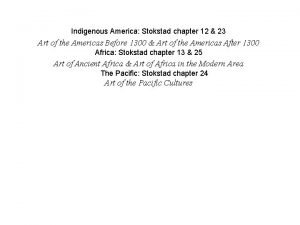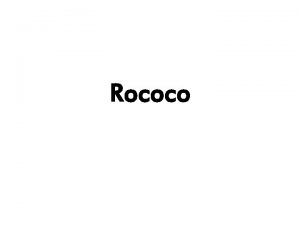A Review of Isms from Stokstad chapters 19















- Slides: 15

A Review of Ism’s from Stokstad: chapters 19 and 26 and 27

Baroque A period in the history of art lasting from the end of the 16 th century (1580’s) into the 18 th century (1700’s). As a formal style, Baroque is characterized by • open compositions in which elements are placed or seem to move diagonally in space • a loose, free technique in which the artist uses rich colors and dramatic contrasts of light and dark • tenebrism : a technique in which forms emerge from a dark background into a strong light that often falls from a single source outside the painting • visual verisimilitude; naturalism; a desire for realism

Baroque Often in Baroque Art, the viewer is purposefully drawn into the frame of the work of art so that the viewer becomes a participant. This effect may be achieved through the composition and/or the content of the work. The viewer was expected to be emotionally involved in the work of art; the work was intended to draw the viewer in visually and/or emotionally.

Rococo Characteristics of Rococo • According to Stokstad, Rococo is refined, fanciful, and often playful (939). • Rococo is characterized by pastel colors, delicately curving forms, dainty figuresm and a light-hearted mood. • Appeared in France around 1700, primarily as a style of interior design as the French court moved from Versailles back to Paris and all the rich courtiers (think entourage but incredibly wealthy) redecorated their hotels (mansions) in the latest style of the moment. • Paintings on canvas were used to decorate the walls.

Characteristics of Rococo: • According to Gardner, Rococo appeared in France around 1700, primarily as a style of interior design (780). • Shells and shell forms are the principal motifs in Rococo ornament • Expect irregular painted shapes surmounted by sculpture (imagine a painted surface with a white, sculpted putto on top). • Painting, architecture, and sculpture will combine to form a single ensemble, (see Francois de Cuvillies, Hall of Mirrors, the Amalienburg, Nymphenburg Palace park, Munich Germany, early 18 th century). • Expect soft colors; themes of love and happy scenes in outdoor settings Hall of Mirrors a putto

Neoclassicism is the name given to a Western movement in the decorative and visual arts and architecture that drew inspiration from the "classical" art and culture of Ancient Greece and Rome. 18 th-century Neoclassical art responded to the perceived excesses of the contemporary Rococo style with a greater restraint in composition and severity of line. Neoclassical architecture emulated both classical and Renaissance (see Alberti’s façade of Sant’Andrea, Mantua, 1470) structures, emphasizing order and simplicity. The subject-matter of Neoclassical art and literature was inspired by the emphasis on martial (military) courage recorded in the Greek and Latin epics (The Illiad, The Odyssey).

Neoclassicism was a movement begun primarily by one very influential man: Johann Winckelmann published a pamphlet, Thoughts on the Imitation of Greek Work in Painting and Sculpture that was enormously influential. In this pamphlet Winckelmann 1. attacked Rococo as “decadent” and 2. argued that only through the imitation of classical models could art become great once again.

Romanticism is a complex artistic, literary, and intellectual movement that originated in the second half of the 18 th century in Western Europe. In part, it was a revolt against aristocratic social and political norms of the Age of Enlightenment and a reaction against the scientific rationalization of nature, and was embodied most strongly in the visual arts, music, and literature, but can be detected even in changed attitudes towards children and education.

Romanticism The movement validated strong emotion as an authentic source of aesthetic experience, placing new emphasis on such emotions as trepidation, terror, horror and awe—especially that which is experienced in confronting the sublimity of untamed nature and its picturesque qualities, both new aesthetic categories. In European painting, led by a new generation of the French school, the Romantic sensibility contrasted with the Neoclassicism being taught in the academies.

Romanticism In a revived clash between color and design, the expressiveness of color, as in works of Turner, Gericault, and Delacroix, was emphasized in the new prominence of the brushstroke and impasto and in the artist's free handling of paint, which tended to be repressed in neoclassicism under a self-effacing finish.

Romanticism Usually Romantic works have dramatic and intensely emotional subject matter but Romantic landscapes also often also meant to convey the artist’s almost religious reverence for the landscape—which became increasingly important as a industrial revolution intensified. Romantic landscape painting is dramatic • the content emphasizes turbulent or fantastic natural scenery • disasters • the sublime (something that inspires awe) naturalistic • the content represents tranquil nature • the content signals a religious reverence toward nature Romantic painting is characterized by • • • fluid, loose brushwork strong colors complex compositions powerful contrasts of light and dark expressive poses and gestures

Realism A term first used in 1850 to describe a kind of naturalism that had a political or social message: think Courbet or Daumier.

Impressionism began as a loose association of Paris-based artists whose independent exhibitions brought them to prominence in the 1870 s and 1880 s. The name of the movement is derived from the title of Monet’s Impression: Sunrise which provoked a critic to describe his work satirically as just a bunch of impressions—not “real” painting at all.

Impressionism Works of art that are considered examples of impressionism have at least a few of these characteristics: • visible brushstrokes • the artist is usually interested in representing the particular quality of light of a specific moment • often the works are painted in en plein air (outdoors) • paint is used opaquely (not painted on in thin glazes like Rogier van der Weyden did in the painting Portrait of a Lady) • often the work is framed in an abrupt manner (figures are truncated) Nota Bene: the mid-century introduction of premixed paints in lead tubes (resembling modern toothpaste tubes) allowed artists to work more spontaneously; before, artists had to laboriously mix their own paints.

Impressionism: japonisme These characteristics suggest that the artist was probably influenced by Japanese woodblock prints. A characteristic of Impressionism is the evident influence of Japanese prints. – a tendency toward flatness (the background presses toward the surface or foreground of the image) – flat areas of strong color – surface patterning; the decorative quality of the surface pattern becomes almost as important as the content represented – asymmetrical composition (the compositional freedom in placing the subject off-centre) – abrupt framing – a lack of perspective and shadow – a high horizon line
